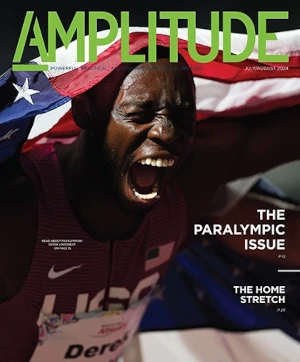By Amy Di Leo, MS
“Pain changes my mood rapidly. All kinds of emotions run through my head. I try to stay relaxed because the more anxious I am, the more intense the pain becomes.”
—Cathy Sampo
Painful Decision
Cathy Sampo, of Arlington, Illinois, is a recent amputee. She made the decision to have her right leg amputated above the knee in early 2017 because of pain associated with an infection and other serious medical issues. Since the surgery, however, Sampo continues to suffer with pain, albeit a different kind.

“The phantom limb pain started the day after my surgery and continues to this day,” says the 58-year-old widowed mother and grandmother. “I have burning, throbbing pain in my shin that’s not there. I feel electric bolts shooting down my leg and out the toes that are not there. Some days are worse than others. The weather and my activity level can make the pain worse. Sometimes the more I do during the day, the worse my phantom pain is at night. I no longer know what it is like to get more than four hours of sleep at night.”
As Sampo is learning through her own research, and from talking to other amputees, everyone’s pain is different. She’s hopeful that hers will eventually go away completely or at least get better with time.
According to a research paper titled “Management of Pain in the Amputee,” by Maurice D. Schnell, MD, and Wilton H. Bunch, MD, PhD, it will.
“The most common factor precluding successful outcome following lower-limb amputation is residual pain, which occurs in approximately 80 percent of patients at some point following a major extremity amputation,” the authors note. “For the majority of these patients, this pain will gradually resolve.”

Pain Points
After 35 years as a below-knee amputee as a result of a motorcycle accident, former British Royal Marine Jeremy “Jez” Scarratt attests to still feeling many types of pain.
“Nerve endings for me are hugely affected by many outside variants, which include ambient air pressure and alcohol consumption,” explains the 58-year-old dad and husband. “The feeling is physical and not in my mind. I have learned that the more constant the air pressure, the better the nerves feel.”
Scarratt, of Somerset, England, explains his painful feelings. “I get very low and moody. I very rarely will say that my leg genuinely hurts because it’s now clearly part of my normal life. Withdrawn is the most common feeling I feel; also, unsociable and especially unsmiling. Though I often appear to be sad and unhappy, in fact I’m not; it’s just the way my pain has manifested itself in me over the years.”
For Scarratt, who no longer takes prescription medications, keeping busy is integral to his personal pain management. For the past five years, he’s taken on some acting roles in live theater and in films as a movie extra. His acting credits include Wonder Woman and Fury, starring Brad Pitt. He also performed as a “sway poler” in the 2012 Paralympic Games Opening Ceremony. He says he also gets enjoyment from helping others, including presenting inspirational talks to kids in his hometown.
But none of this gives him his greatest pain relief. Instead, that comes from his new cat, Lily, and cycling.
My medicine is my bike,” he says. “My physiotherapist is my bike, and my heart pushes the pedals. I keep very fit by cycling and have done many endurance-based rides spanning hundreds of miles over several days in the UK and abroad. Over the years, the miles have run into the thousands. Occasionally, I cycle in a group. Being sociable is good, but often being sociable can be hard. Riding on my own cannot be beaten as it gives me quality time to clear my often-foggy head. I cycle almost every day.”

Pain specialist and researcher Felipe Fregni, MD, PhD, MPH, MEd, associate professor of physical medicine and rehabilitation and neurology at Harvard Medical School and director of the Spaulding Neuromodulation Center Department of Physical Medicine & Rehabilitation in Boston, says Scarratt has tapped into something significant—the strong correlation between cognitive-physiological and psychosocial aspects of chronic pain.
“Many studies have shown that practicing physical exercise can increase pain threshold and pain tolerability,” Fregni explains. “Brain changes occur during exercise that have been shown to mediate pain pathways. Therefore, incorporating regular physical exercise into the overall treatment plan for chronic pain patients can be beneficial. Additionally, it has been shown that spending time with a pet or loved one, reading a good book, watching a funny movie, or cooking a favorite meal are all positive activities that have a positive effect on pain modulation as these activities activate the emotional-related brain areas that can mediate pain. Activities that focus on mindfulness such as yoga, tai chi, and meditation can help to elicit a relaxation response, which, in turn,helps to modulate pain.”
Treatment Toolbox
“It is important for patients to create a personal toolbox of treatment approaches, pain treatment modalities, and coping skills to help better manage their pain,” Fregni explains.
Prescription pain medications and using cold and warm compresses on her residual limb are in Sampo’s toolbox. Living in a small, rural town of 300 people, she says her daughter and niece have been very supportive and that helps. She’s also found some comfort in connecting with other amputees in online support groups.
“Support groups for people with limb loss and also for chronic pain can be beneficial,” Fregni adds. “Connecting with others who share a similar experience of dealing with limb loss and chronic pain is very therapeutic to the recovery process.”
“I try to stay positive, but it sure is hard,” Sampo says. She recently had to retire from her job as an activity director at a behavioral health facility in Arizona and move back to Arlington to be closer to her loved ones. She’s still getting used to her life changes and finds it difficult to talk to anyone about her amputation.
“It is not easy when I look back at what my life was and all I accomplished versus where I am today,” she shares.
The Psychology of Pain
“There is well-known correlation between chronic pain and psychiatric symptoms, such as depression and anxiety,” Fregni explains. “But patients who experience chronic pain are also more susceptible to having depression and anxiety disorders. In chronic pain, the brain centers that process emotions and feelings are activated, while chronic activation of these centers can lead to depression and anxiety.”
Citing several studies determining that patients who are socially supported by family, friends, and members of the community show increased psychological benefits, Fregni says, “It is important for patients dealing with limb loss and chronic pain to effectively assert their feelings to help their social support system to become more empathetic to them.”
He adds that mental health providers can help patients more effectively communicate their feelings and needs to loved ones, and to do so, patients can use phrases like “When this happens, it makes me feel….”
“I had always been an outgoing person—always on the go,” Sampo says. “Now I find myself wanting to be alone. Friends have disappeared. I feel such a loss. I feel helpless. Tasks that used to take me little time now take much, much longer to do. I easily get frustrated and tire easily.”
Fregni explains, “Pain can take a huge toll on interpersonal relationships. Learning effective communication strategies can help alleviate the tension. In turn, the feeling of being well-supported, heard, and understood can help patients improve their self-esteem, confidence, and coping skills.”
Why Pain?
What are some of the physical causes of pain? Besides phantom limb sensation and phantom limb pain (see pg. 26), Schnell and Bunch cite several maladies that can be painful for an amputee.
Neuromas, which are bundles of nerve endings under the skin of the residual limb, can become very sensitive, especially if they are pressing on a prosthesis. Reflex sympathetic dystrophy includes burning, tenderness, and swelling of a residual limb, which causes pain. Bursitis and tendinitis and their painful inflammation are also not uncommon for amputees.
And what if a prosthesis causes pain or increases existing pain on your residual limb? Taking it off to let the limb heal can be prescribed, but that can sideline you for a long time and make you miss work, school, or social events. Products such as GlideWear prosthetic liner patches (www.glidewear.com) and Adaptskin (www.adaptlabs.com), which reduce friction where your socket and limb meet, might help prevent the injury and pain before it gets to that point. If not, having a backup plan and being willing t o use a wheelchair or crutches to get around temporarily can get you back to your daily activities quicker. That could be important both physically and psychologically. When pain forces you to stop living, it can make you feel angry, depressed, and defeated. When you are able to persevere despite setbacks, it will make you feel more like a winner rather than allowing your pain to control you.
Pain Management
The management of pain is usually a multidisciplinary approach, and Fregni suggests filling your treatment toolbox with a varied team of healthcare professionals.
“An amputee’s healthcare team should include a primary care doctor; physiotherapy, rehabilitation, and pain management specialists; physical therapists; occupational therapists; nurses; social workers; psychologists; and psychiatrists,” he says. “Alternative medicine providers, such as massage therapists, chiropractors, holistic healers, as well as meditation, reiki, and yoga instructors, can add a different dimension to the care team [and potentially help patients manage their pain].”
He adds that another tool, called non-invasive brain stimulation, has become a promising option for treating pain and that transcranial direct current stimulation, which is a small and constant electrical current over the scalp, has shown to be effective in the treatment of chronic pain.
This article is for general informational purposes only and does not constitute medical advice. Always seek the advice of a qualified healthcare professional for your specific situation.
It is important for patients to create a personal toolbox of treatment approaches, pain treatment modalities, and coping skills to help better manage their pain.



